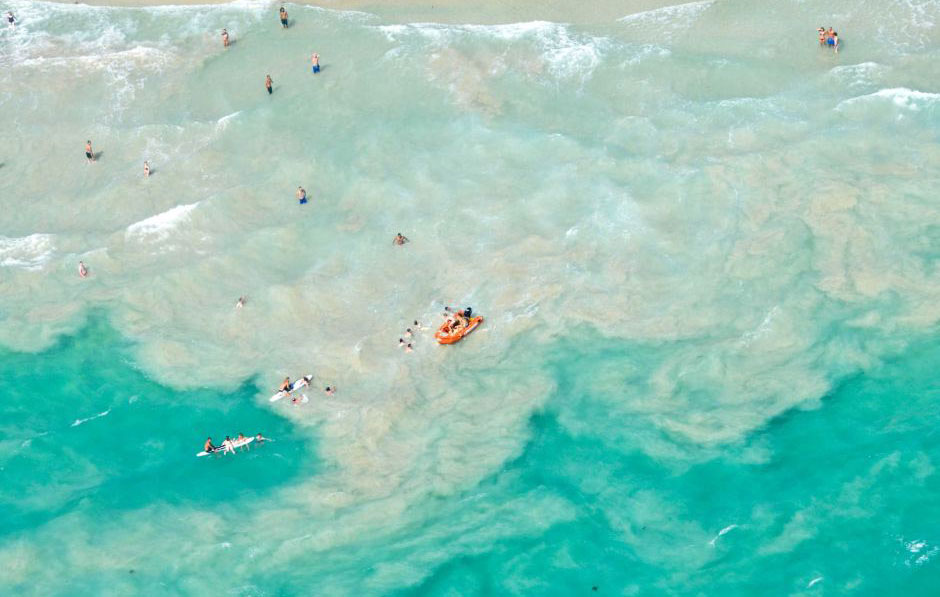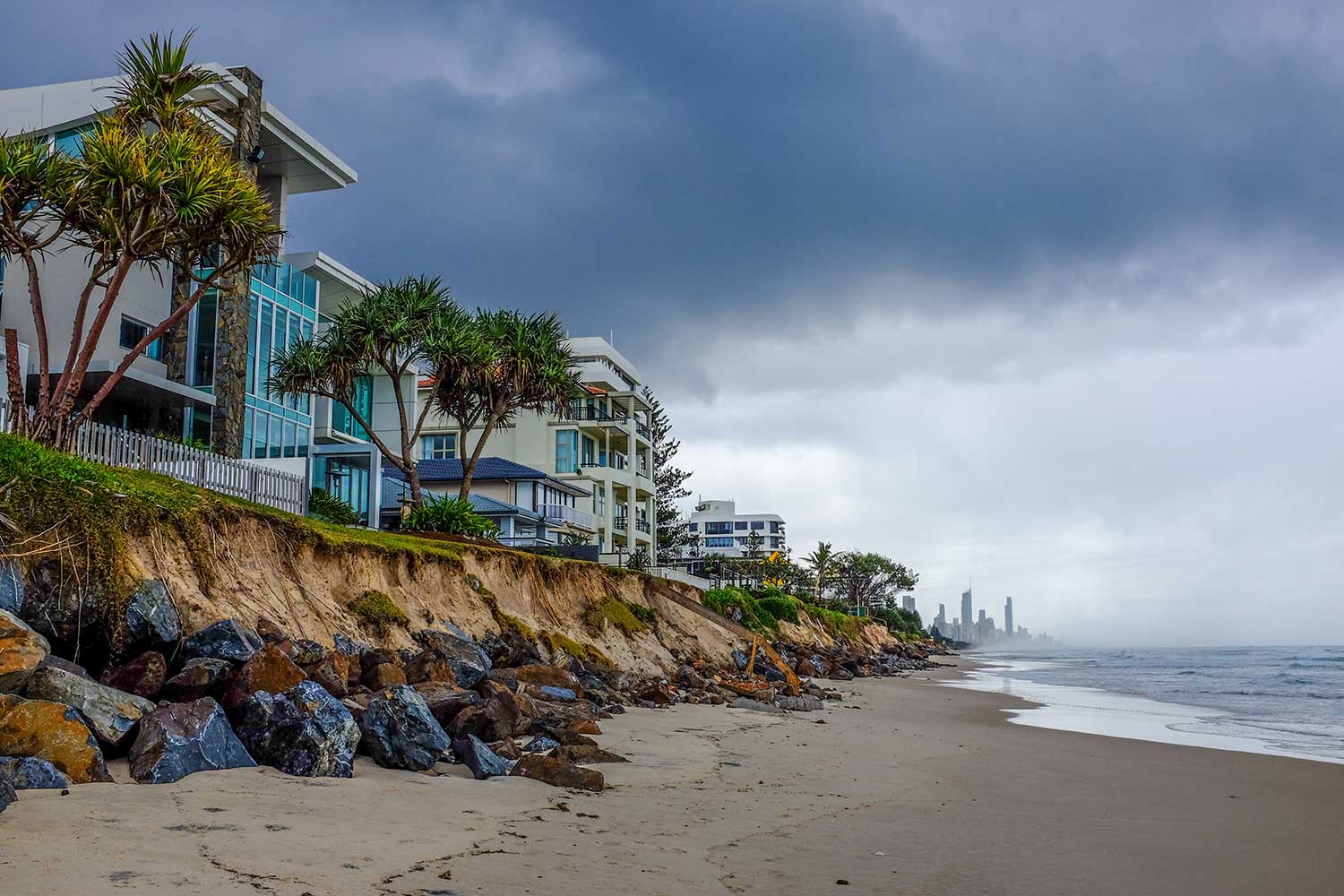Rip currents are the major natural hazard on Australian beaches accounting for around 90% of the rescues and are responsible for at least 21 drownings on average per year according to Life Saving Australia. On average rip currents result in more deaths each year than sharks, bushfires, floods and cyclones combined.
Yet, the most dangerous type of rip current, the flash rip, is poorly understood with no research being conducted on the phenomenon in the southern hemisphere, until now.
Tom Murray is a PhD candidate in the School of Engineering and a research assistant at the Griffith Centre for Coastal Management. Tom’s research is searching to understand the conditions that generate the rips, how long they last and how often they form. It is hoped this knowledge could lead to a management plan to deal with flash rips and eventually save lives and limit rescues.
What are flash rips?
Tom explains, “Flash rips are known in the scientific community as ‘transient rip currents.’

“They appear suddenly without warning, have a short-lifespan and decay after a few minutes. This means they are really hard to research; they are very difficult to capture and study using traditional field equipment and methodologies.”
They are not as common on Gold Coast beaches as topographically controlled rip currents, which are semi-permanent in position, remaining in roughly the same place for several days.
A topographic rip is characterised by a deep, shore-normal aligned channel between two neighbouring sand bars. Waves break over the adjacent shallow bars and the water piled up from the broken waves near shore returns seaward in the channel. An experienced observer can usually spot a topographic rip by watching the wave breaking patterns of several wave groups and the movement of the residual foam on the surface.

The collapsing sand bar myth
Multiple swimmer rescue events are regularly reported in the media as being caused by a ‘collapsing sand bar.’
“Sand bars cannot and do not suddenly collapse,” says Tom.
Rescued swimmers often report feeling the sand bar just ‘disappearing’ beneath their feet. When a swimmer (or group of swimmers) suddenly becomes detached from the sand bar a flash rip is usually the culprit. There may be no well-defined rip channels in the immediate area however groups of incoming breaking waves still lead to localised ‘wave set-up’ shoreward of the breaking zone (i.e. a local elevation of the water level near the shore).
“As all that water travels back out to sea the depth of the water suddenly increases simply lifting people of the sand bar. The sand bar didn’t collapse they simply floated off it,” explains Tom.
“Once they are floating in the rip they are taken out into deeper water. It can be very freighting especially for people not used to the ocean and waves.”
This can be thought of like a pulse of energy as the gradient in water level induces a current that moves the excess water back offshore.
How do flash rips impact swimmers?
Whilst flash rips tend to not be as large or as consistently flowing and pulsing as their semi-permanent counterparts they can move bathers from shallow to deep water rapidly and un-expectantly.
“Once an inexperienced swimmer is beyond waist deep water depth they are at risk of drowning. It is important to remember there is no force in a rip current that will pull a swimmer underneath the surface of the water,” continues Tom.
“Drownings generally occur due to panic and exhaustion. It is a really dangerous event and that is why I wanted to understand it more.”
Rip events
- 20 swimmers rescued by lifeguards at Scarborough Beach, Perth, WA
- 18 swimmers rescued off North Burleigh Beach
- Fatality at Stanwell Beach
- Black Sunday Bondi Beach 1938
Rip Hazard Research at Griffith
“The only way to capture and study enough flash rips was to use video-imaging. This could measure the geometry and velocity of flash rips. Data was also collected on their occurrence, spacing, mobility and duration,” explains Tom.
This study is the first in the Southern Hemisphere with only one known, small study being conducted previously on flash rips on beaches on Long Island, New York. The use of video-imaging techniques allows for a cost-effective and accurate study of these features, which are very difficult to locate and study using traditional surf zone equipment and methodologies (e.g. GPS drifters, acoustic current profilers, pressure gauges etc.). The features are easily identified as plumes of sediment laden water extending offshore of a section of coast devoid of any obvious rip channel morphology. They are characterised by a narrow rip neck and mushroom cloud rip head which can consist of vortex pairs shedding offshore from the jet.

A camera system located on top of the Waterford building at Narrowneck (approximately 100 m above mean sea level) gives a wide view of the beach and surf zone and was used to describe the nature and occurrence of flash rips along a 1.1 km stretch of coastline.
“We caught 233 individual flash rip events in over 1000 hours of video footage,” says Tom.
“Some of the key thing we discovered where there are around 2 flash rips occurring per kilometre per day and they are fairly random both where and when they occur.”
“I guess this is why they haven’t been studied using conventional field equipment and methodologies. “
Average flash rip duration lasted around 83 seconds and their durations ranged from approximately 30 seconds to just under 4 minutes. For the first time video-image techniques measured the geometry, mobility and velocity of these transient surf zone hazards. Rip necks were generally on the order of 5 to 15 m wide with the length of the rip ranging between 9.8 – 87.4 m. The average rip length was around 33 m.
Rip speeds ranged from 0.1 – 1.3 m/s with the majority of rips having an average speed of 0.2 – 0.6 m/s.
“This is on the lower end of the rip energy scale but still has the potential to move swimmers from shallow to deep water fairly rapidly,” says Tom.
How do they form?
As these features are so difficult to study it still remains somewhat of a mystery what drives the formation of these temporary features. Flash rips are driven primarily by hydrodynamics (i.e. waves breaking) rather than topographic constraints (i.e. changes in water depth that tend to control the semi-permanent beach rips). Tom’s research found that flash rip occurrence did not favour any particular average wave or wind conditions.
Traditionally it was believed that flash rip occurrence favoured messy seas or conditions where multiple wave sources are present. Messy seas or multiple swell sources cause short-lived variations in the local water level due to wave-set up and set-down, driven by wave breaking. As rip currents are pressure driven, water will run ‘downhill’ from places of high water to low water. So if there are temporary changes in the water level, short-lived currents can be produced.

Tom’s research also found that flash rip formation favours less stochastic ‘sea state’ conditions; flash rips were observed to occur more frequently when swell was present as opposed to choppy, wind-sea conditions.
In the past one to two years interest in the dynamics of flash rip currents has been increasing particularly in the US and France. Scripps Institution of Oceanography at the University of California in San Diego has begun large scale field experiments and numerical modelling experiments to further understand the drivers behind flash rip currents and in the future it is hoped to be able to predict their occurrence. Recent research suggests there are two key driving mechanisms for flash rips which are:
- Shear instabilities in the longshore current
- Short-crested breaking wave vorticity forcing due to along-crest variation in wave dissipation
Publications
Tom has one paper published in a Special Issue of the Journal for Coastal Research titled ‘Video-imaging of transient rip currents on the Gold Coast open beaches.’ Another paper on video-image derived flash rip geometry is in preparation and he is on track to finalise his PhD by the end of 2015. Tom has presented results of his research at the 2nd International Rip Current Symposium in Sydney in 2012 and at the 8th International Coastal Symposium in Southampton, UK in 2013.
Final Note
Remember to always swim between the flags within patrol hours, heed the advice of lifeguards on duty and always be aware of changing water levels and currents when venturing into the surf zone.






